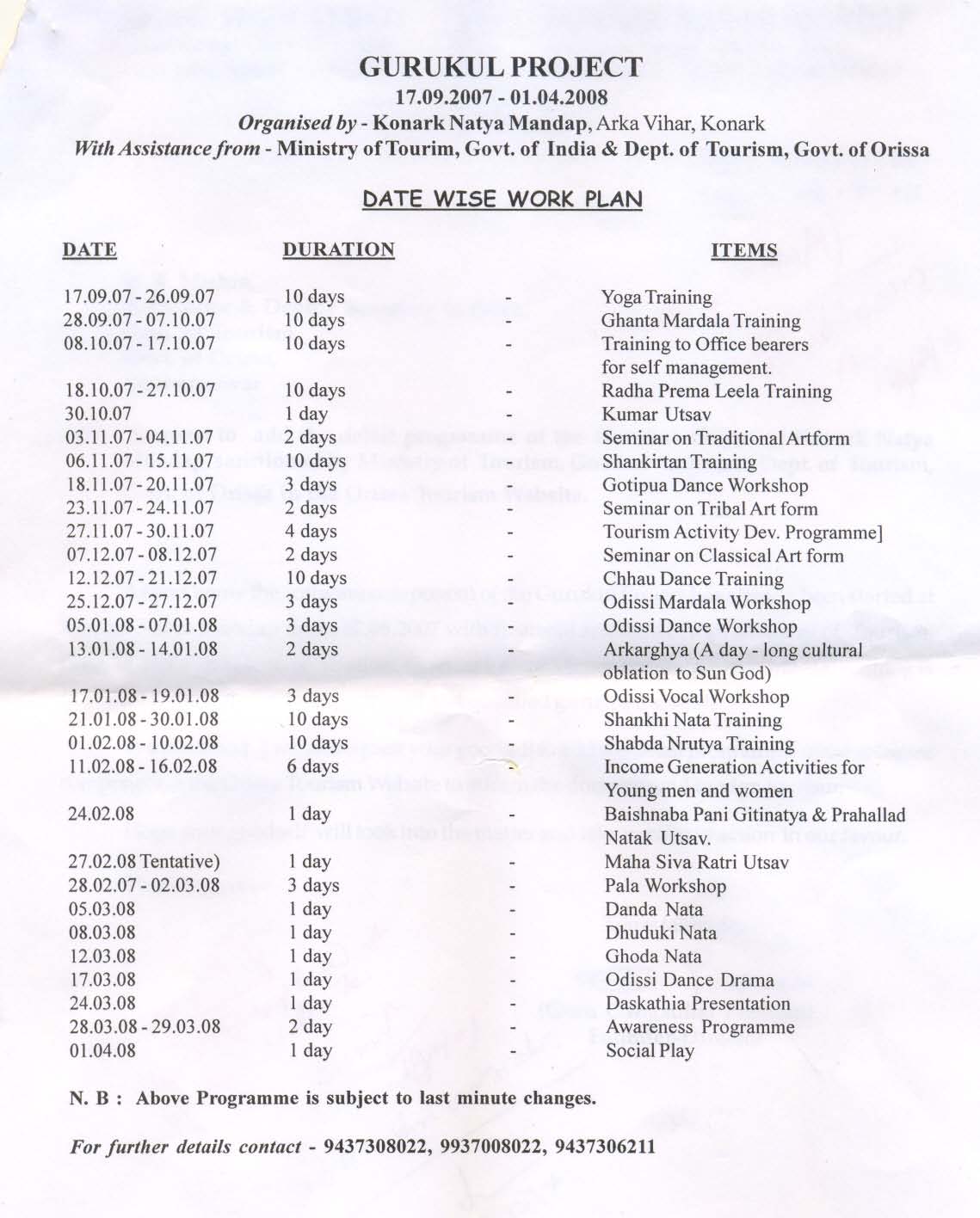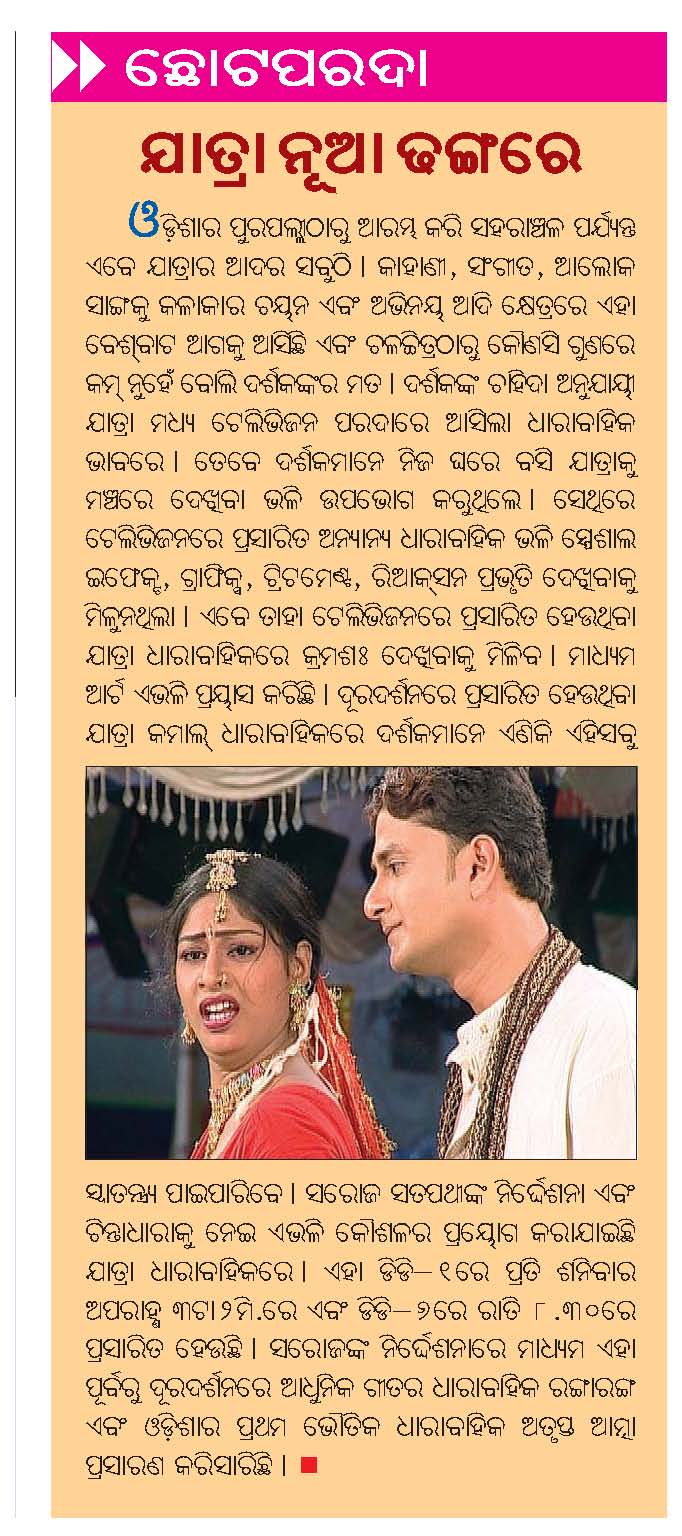Eastern zonal Cultural center has all its infrastructure in West Bengal
Central govt. schemes, Demanding equitable treatment, Jatra, Odia music, Odisha artists, Odisha Culture, Odisha dances, Odisha govt. Inaction, Palla and Daskathia, Puppetry 1 Comment »Following is from the PIB http://pib.nic.in/release/release.asp?relid=62636 which brought our attention to the zonal cultural centers funded by the Ministry of Culture, Government in India. By looking at the web page of the Eastern Zonal Cultural Center in Kolkata, it seems like all of the infrastructure of this center is in West Bengal.
The aims and objectives of the Zonal Cultural Centres (ZCCs) are to preserve, promote and disseminate the arts, specially folk/tribal arts of the country. The ZCCs endeavour to develop and promote the rich diversity and uniqueness of various arts of the Zone and to upgrade and enrich consciousness of the people about their cultural heritage.
There are only seven ZCCs in the country. Though no ZCC has its headquarters in Karnataka, the state of Karnataka is a member of the South Zone Cultural Centre (SZCC), having its headquarters at Thanjavur and also of South Central Zone Cultural Centre (SCZCC) having its headquarters at Nagpur.
The details of ZCCs, location-wise and the schemes/programmes organised/executed by each centre, ZCC-wise are annexed.
Annexure
Government has set up seven Zonal Cultural Centres (ZCCs) having headquarters in various part of the country as per the details given below:-
|
Sl. No. |
Name of the centre |
Headquarters |
Member States |
|
1 |
North Zone Cultural Centre |
Patiala |
Jammu & Kashmir, Himachal Pradesh, Punjab, Haryana, Uttarakhand, Rajasthan and Union Territory of Chandigarh |
|
2. |
West Zone Cultural Centre |
Udaipur |
Rajasthan, Maharashtra, Gujarat, Goa, Union Territories of Daman & Diu and Dadra & Nagar Haveli |
|
3 |
South Zone Cultural Centre |
Thanjavur |
Andhra Pradesh, Karnataka, Kerala, Tamil Nadu, Union Territories of Andaman & Nicobar Islands, Lakshadweep, Puducherry. |
|
4 |
South Central Zone Cultural Centre |
Nagpur |
Andhra Pradesh, Chhattisgarh, Karnataka, Madhya Pradesh and Maharashtra |
|
5 |
Eastern Zonal Cultural Centre |
Kolkata |
Assam, Bihar, Jharkhand, Manipur, Orissa, Sikkim, Tripura, West Bengal and Union Territory of Andaman and Nicobar Islands. |
|
6 |
North Central Zone Cultural Centre |
Allahabad |
Uttar Pradesh, Madhya Pradesh, Bihar, Haryana, Rajasthan, Uttarakhand and NCT of Delhi. |
|
7 |
North East Zone Cultural Centre |
Dimapur |
Arunachal Pradesh, Assam, Manipur, Meghalaya, Mizoram, Nagaland, Sikkim and Tripura. |
The ZCCs have been carrying out various activities in accordance with their aims and objectives:-
I. National Cultural Exchange Programme: With a view to present art forms of one region to another and expose the diverse cultural heritage of each region to the rest of the country, the folk/tribal artistes are sent on exchange manner to participate in the programmes organized by the seven Zonal Cultural Centres.
II. Guru Shishya Parampara Scheme: The Scheme was introduced in 2003-04 with a view to promote development of new talents in the field of music and dance, folk and tribal art forms, under the able guidance of Gurus.
III. Young Talented Artistes Scheme: The Scheme was introduced during the year 2004-05 to recognize and encourage young talents in the various Folk/Tribal arts forms in different regions in the country.
IV. Documentation of Vanishing Art Forms: Under the Scheme, documentation of various folk and tribal art forms is undertaken, especially of those which are seen to be vanishing.
V. Shilpagram Activities: ZCCs have set up Shilpagrams at Chandigarh, Khajuraho, Udaipur, Guwahati, Allahabad and Shantiniketan to encourage various forms of folk/tribal arts and crafts from rural India. These Shilpagrams are attracting a large number of domestic as well as foreign visitors. Through these Shilpgrams, a number of artistes and artisans are benefited and a large number of people are made aware of our rich cultural heritage.
VI. Loktarang – National Folk Dance Festival and OCTAVE – Festival of the North East: All the ZCCs participate in these National level festivals organized every year in New Delhi and/or other places. A large number of folk/tribal artistes from all corners of the country performs during these festivals to showcase the diverse folk/tribal arts of our country.
Following is from the "About Us" page of the Eastern Zonal Cultural Center.
The idea for Zonal Cultural Centers germinated in the mind of our late Prime Minister, Rajiv Gandhi. At his instance, several centers were set up. They represent the effort on the part of the Government and the people to preserve and protect our rich cultural heritage and to bring it closer to the lives of the people. With each State or Union Territory belonging to at least one Zonal Center, the objective is to foster amongst the people within each zone and among zones, much greater cultural exchanges and understanding. This not only results in a better understanding of our heritage but also brings out the underlying unity of our diverse cultural traditions.
A self-transforming civilization that defies any attempt to freeze it in space and time, living India is a mosaic of varied cultures, layer upon layer, tempered in a history of a common vitality.
Since independence, it has been the concern of the Government of India to encourage the evolution and consolidation of Indian culture by bringing its different streams closer and by making people of various regions know and understand each other’s distinctive traits in a spirit of appreciation and acceptance of the unity in diversity within this country.
The establishment of the Zonal Cultural Centers, in collaboration with the State Governments and Union Territories, is one of the measures taken by the Government of India to achieve this objective.
The Eastern Zonal Cultural Center (EZCC) covering the states of Assam, Bihar, Jharkhand, Manipur, Orissa, Sikkim, Tripura, West Bengal and The Union Territory of The Andaman and Nicobar Islands is one of the seven such Zonal Cultural Centers set up by the Government of India with a view to culturally integrate the states and Union Territories as a part of the program of national integration.
Since its inception in 1985 the EZCC has been functioning as a cultural nerve center, between and among the numerous ethnic cultural centers/groups of excellence of the eastern parts of the country. The Center strives through its various activities to enrich, promote and strengthen these traditions. The Center is totally dedicated to the promotion, projection and dissemination of our traditional culture.
Over the past several years, the EZCC has been able to infuse among people a conscious appreciation of the rich cultural heritage of its own zone as well as other parts of the country through its manifold programs of folk, tribal and classical dance music and dance, documentation and publication, workshops, as well as its exhibitions on arts and crafts.
The numerous fairs and festivals, seminars and symposia organized through out the year are efforts to combat the constant onslaught of the electronic media.
The Center is under the overall supervision of the Department of Culture, Ministry of Tourism and Culture, Government of India and is headed by the Director. His Excellency the Governor of West Bengal is the chairman of the EZCC.
The more we try to unravel the mysteries of our own many splendoured culture, the more we perceive the underlying strength of unity and harmony that rises above all differences and distinctions and enmeshes us in its inherent bonds. This is what we are committed to project and promote.
The following is from the Infrastructure page of the Eastern Zonal Cultural Center.
A. The Bharatiyam Cultural Multiplex is situated at IB-201, Sector III, Salt Lake City, Kolkata 700106.
The facilities available at the Bharatiyam Cultural Multiplex include
- Purbashree (Main Auditorium)
Air conditioned auditorium measuring 7850 square feet, having a capacity for over 900 persons.

- Rangmanch (Open Air Theatre)
Open Air Theatre measuring 4000 square feet has been built with a seating capacity of about 400 people. - Naat Ghar (Studio Theatre)
Air conditioned studio theatre measuring 1200 square feet has a seating capacity for 100 persons. - Sobha Ghar (Art Gallery)
The air-conditioned art gallery measures 3280 square feet. The exhibition wall is provided with track lighting.
 |
 |
 |
 |
 |
 |
 |
 |
 |
  |
|
|
 |
|
- Food Court
The open air Food Court measuring 2000 square feet with its ethnic background is an ideal place for hosting food festivals etc.
B. The Aikatan Cultural Center is situated at IA-190, Sector III, Salt Lake City, Kolkata 700097.
The facilities available at the Aikatan Cultural Complex include
|
 |
C. SRIJANI, the Shilpagram Complex of the EZCC is situated in Santiniketan, Bolpur in Birbhum District of West Bengal.
| This unique cultural center provides a conducive and infrastructure to nurture our traditional arts and crafts.
The complex comprises of huts, representative of EZCC’s member states. The huts incorporate traditional architectural features and design. |
|
The question is if the Eastern Zonal Cultural Center is supposed to cater several states in the Eastern part of India, including Odisha, why is all of its infrastructure in West Bengal.
This means the system of zonal cultural center is not working. The GOI must exapnd it to all major states and establish a similar center in Odisha. Odisha CM must lobby for it and make sure it is included in the next five year plan starting from 2012.






